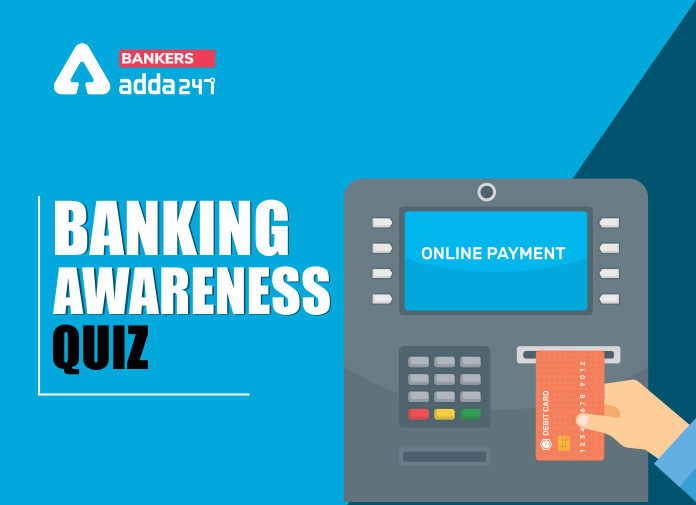The Banking Awareness section constitutes a major part of a competitive examination and needs your undivided attention. With the increased competition in the field of Banking examinations, it has now become very important to cover up all the sections efficiently.
Banking Affairs 21st September 2020 Quiz
To complement your preparation for General Awareness section of the upcoming exams like SBI Clerk Mains and RBI Assistant Mains we are providing you Banking Awareness Quiz of 21st September 2020 covering the following topics: NPA, MUDRA, EPZ, DIC, CGCI, Risk Management.
Q1. __________ An asset, including a leased asset, becomes non performing when it ceases to generate income for the bank.
(a) NPA
(b) KCC
(c) NPV
(d) GDP
(e) GNP
Q2. What is the full form of NPA?
(a) National Performing Assets
(b) New Performing Assets
(c) Non Production Assets
(d) Non Performing Assembly
(e) Non Performing Assets
Q3. MUDRA is a financial institution has been set up by Government of India for development and refinancing micro units’ enterprises. What is the meaning of “A” in MUDRA?
(a) Agency
(b) Association
(c) Assembly
(d) Agent
(e) Alert
Q4. MUDRA stands for ___________________.
(a) Micro Units Development & Refinance Agent
(b) Midium Units Development & Refinance Association
(c) Micro Units Department & Refinance Agency
(d) Micro Units Development & Refinance Agency
(e) Micro Unique Development & Refinance Assembly
Q5. India was one of the first in Asia to recognize the effectiveness of the EPZ model in promoting exports. EPZ stands for____________.
(a) Export Point Zone
(b) External Processing Zone
(c) Export Production Zone
(d) Export Processing Zone
(e) Export Processing Zonal
Q6. The concept of insuring deposits kept with banks received attention for the first time in the year ___________ after the banking crises in Bengal.
(a) 1941
(b) 1933
(c) 1961
(d) 1948
(e) 1919
Q7. The Deposit Insurance Corporation (DIC) Bill was introduced in the Parliament on August 21, 1961. After it was passed by the Parliament, the Bill got the assent of the President on December 7, 1961 and the Deposit Insurance Act, 1961 came into force on January 01st- ________.
(a) 1962
(b) 1975
(c) 1956
(d) 1949
(e) 1935
Q8. The Reserve Bank of India was promoted a public limited company on January 14th 1971, named the CGCI. What was the meaning of first “G” in CGCI?
(a) Grace
(b) Goodwill
(c) Global
(d) Gross
(e) Guarante
Q9. The DIC Bill was introduced in the Parliament on August 21st 1961. What is the meaning of “D” in DIC?
(a) Distance
(b) Development
(c) Deposit
(d) Demand
(e) None of the given options is true
Q10. DICGC stands for _____________.
(a) Deposit Investment and Credit Guarantee Corporation
(b) Deposit Insurance and Credit Guarantee Corporation
(c) Deposit Insurance and Credit Guarantee Company
(d) Demand Insurance and Credit Guarantee Corporation
(e) Deposit Instalment and Credit Guarantee Corporation
IBPS PO and Clerk Prime 2020 Online Test Series
Q11. ______________ is basically charged when a person uses a credit card to obtain cash.
(a) Early Repayment Charge
(b) Redemption Fee
(c) Transaction Fee
(d) Cash Advance Fee
(e) None of the given options is true
Q12. Which is an interest-free period that is to be given by a creditor to debtor?
(a) Fixed Period
(b) Preset Period
(c) Grace Period
(d) All of the Above
(e) None of the given options is true
Q13. ________ is a cheque rather an amount of cheque, which is above the balance available in the account of the payer.
(a) Travellers cheque
(b) Multicity Cheque
(c) Mutilated Cheque
(d) Over Draft
(e) Bad Debts
Q14. A cheque for a fixed amount that may be cashed or used in payment abroad after endorsement by the holder’s signature is known as ___________.
(a) Travellers cheque
(b) Multicity Cheque
(c) Mutilated Cheque
(d) Crossed Cheque
(e) None of the given options is true
Q15. Which of the following is not a measure of the Risk Management in Banks?
(a) CRR
(b) RTGS
(c) SLR
(d) Deposit Insurance
(e) None of the given options is true
Solutions
S1. Ans.(a)
Sol. Non performing Assets (NPA) is an asset, including a leased asset, becomes non performing when it ceases to generate income for the bank.
S2. Ans.(e)
Sol. NPA stands for Non performing Assets.
S3. Ans.(a)
Sol. MUDRA, which stands for Micro Units Development & Refinance Agency Ltd, is a financial institution being set up by Government of India for development and refinancing micro units’ enterprises.
S4. Ans.(d)
Sol. MUDRA, which stands for Micro Units Development & Refinance Agency Ltd, is a financial institution being set up by Government of India for development and refinancing micro units’ enterprises. It was announced by the Hon’ble Finance Minister while presenting the Union Budget for FY 2016. The purpose of MUDRA is to provide funding to the non-corporate small business sector through various Last Mile Financial Institutions like Banks, NBFCs and MFIs.
S5. Ans.(d)
Sol. India was one of the first in Asia to recognize the effectiveness of the Export Processing Zone (EPZ) model in promoting exports, with Asia’s first EPZ set up in Kandla, Gujarat in 1965.
S6. Ans.(d)
Sol. The concept of insuring deposits kept with banks received attention for the first time in the year 1948 after the banking crises in Bengal. The question came up for reconsideration in the year 1949, but it was decided to hold it in abeyance till the Reserve Bank of India ensured adequate arrangements for inspection of banks. Subsequently, in the year 1950, the Rural Banking Enquiry Committee also supported the concept.
S7. Ans.(a)
Sol. The Deposit Insurance Corporation (DIC) Bill was introduced in the Parliament on August 21, 1961. After it was passed by the Parliament, the Bill got the assent of the President on December 7, 1961 and the Deposit Insurance Act, 1961 came into force on January 1, 1962. The Deposit Insurance Scheme was initially extended to functioning commercial banks only. This included the State Bank of India and its subsidiaries, other commercial banks and the branches of the foreign banks operating in India.
S8. Ans.(e)
Sol. The Reserve Bank of India also promoted a public limited company on January 14, 1971, named the Credit Guarantee Corporation of India Ltd. (CGCI).
S9. Ans.(c)
Sol. The Deposit Insurance Corporation (DIC) Bill was introduced in the Parliament on August 21, 1961. After it was passed by the Parliament, the Bill got the assent of the President on December 7, 1961 and the Deposit Insurance Act, 1961 came into force on January 1, 1962.
S10. Ans.(b)
Sol. DICGC stands for Deposit Insurance and Credit Guarantee Corporation.
S11. Ans.(d)
Sol. A cash advance fee is a charge that a credit card issuer charges a customer for accessing the cash credit line on his or her account, either through an ATM, convenience check or at a bank’s teller window.
S12. Ans.(c)
Sol. The grace period is the provision in most loan and insurance contracts which allows payment to be received for a certain period of time after the actual due date. During this period no late fees will be charged, and the late payment will not result in default or cancellation of the loan.
S13. Ans.(d)
Sol. An overdraft is an extension of credit from a lending institution when an account reaches zero. An overdraft allows the individual to continue withdrawing money even if the account has no funds in it.
S14. Ans.(a)
Sol. Traveller’s cheque is a medium of exchange that can be used in place of hard currency. Traveller’s cheques are often used by individuals travelling on vacation to foreign countries.
S15. Ans.(b)
Sol. Cash reserve Ratio (CRR) is the amount of funds that the banks have to keep with the RBI. Statutory liquidity ratio (SLR) is the Indian government term for reserve requirement that the commercial banks in India require to maintain in the form of gold, government approved securities before providing credit to the customers. Deposit insurance is mandatory, and pays claims from a pool of funds to which every depository institution regularly contributes.
Download PDF for this Quiz
Click Here to Register for Bank Exams 2020 Preparation Material
You may also like to read:
- Current Affairs & Daily GK Updates 2020
- Latest GK and Current Affairs Questions With Answers For All Bank Exam
- SBI Clerk Result 2020
- Bihar Board 12th Result 2020
- NEET Admit Card 2020
20-21 September Current Affairs 2020 | Current Affairs Today | Daily Current Affairs 2020
Visit Achieversadda.com and participate in discussions with other aspirants and achievers. Get answers to your queries and connect with others on Achieversadda.com
All the Best BA’ians for RBI Assistant Mains!





 GA Capsule for SBI Clerk Mains 2025, Dow...
GA Capsule for SBI Clerk Mains 2025, Dow...
 The Hindu Review October 2022: Download ...
The Hindu Review October 2022: Download ...
 IBPS PO Apply Online 2025, Online Applic...
IBPS PO Apply Online 2025, Online Applic...


